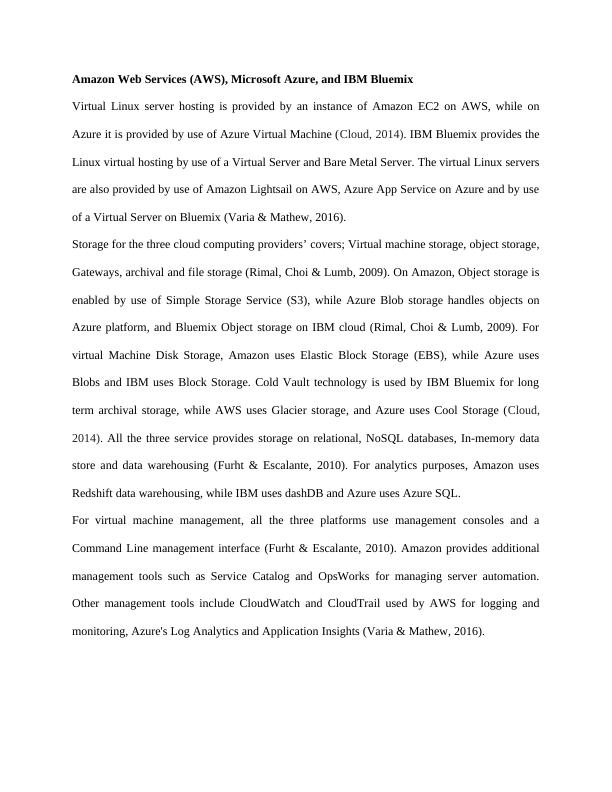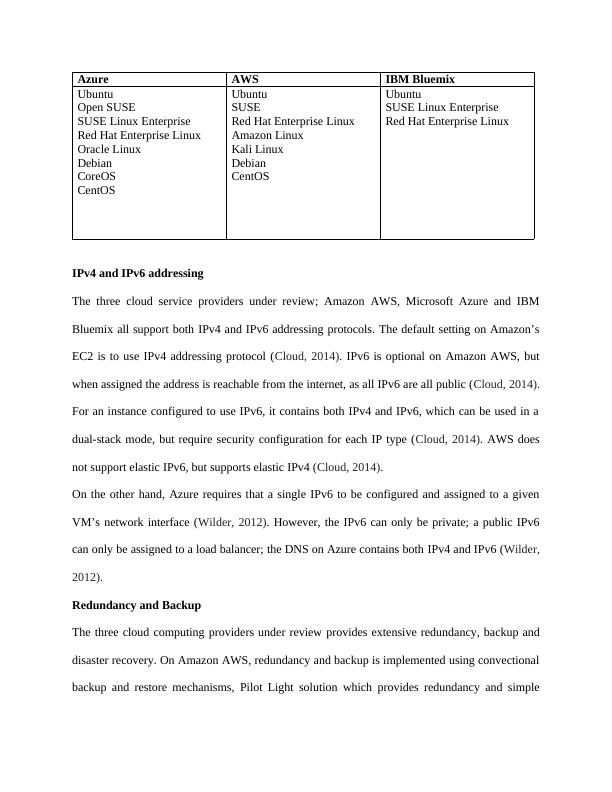Amazon Web Services (AWS) | Assignment
4 Pages1024 Words308 Views
Added on 2020-03-28
Amazon Web Services (AWS) | Assignment
Added on 2020-03-28
ShareRelated Documents
Amazon Web Services(AWS), Microsoft Azure, and IBM BluemixVirtual Linux server hosting is provided by an instance of Amazon EC2 on AWS, while onAzure it is provided by use of Azure Virtual Machine (Cloud, 2014). IBM Bluemix provides theLinux virtual hosting by use of a Virtual Server and Bare Metal Server. The virtual Linux serversare also provided by use of Amazon Lightsail on AWS, Azure App Service on Azure and by useof a Virtual Server on Bluemix (Varia & Mathew, 2016).Storage for the three cloud computing providers’ covers; Virtual machine storage, object storage,Gateways, archival and file storage (Rimal, Choi & Lumb, 2009). On Amazon, Object storage isenabled by use of Simple Storage Service (S3), while Azure Blob storage handles objects onAzure platform, and Bluemix Object storage on IBM cloud (Rimal, Choi & Lumb, 2009). Forvirtual Machine Disk Storage, Amazon uses Elastic Block Storage (EBS), while Azure usesBlobs and IBM uses Block Storage. Cold Vault technology is used by IBM Bluemix for longterm archival storage, while AWS uses Glacier storage, and Azure uses Cool Storage (Cloud,2014). All the three service provides storage on relational, NoSQL databases, In-memory datastore and data warehousing (Furht & Escalante, 2010). For analytics purposes, Amazon usesRedshift data warehousing, while IBM uses dashDB and Azure uses Azure SQL.For virtual machine management, all the three platforms use management consoles and aCommand Line management interface (Furht & Escalante, 2010). Amazon provides additionalmanagement tools such as Service Catalog and OpsWorks for managing server automation.Other management tools include CloudWatch and CloudTrail used by AWS for logging andmonitoring, Azure's Log Analytics and Application Insights (Varia & Mathew, 2016).

AzureAWSIBM BluemixUbuntuOpen SUSESUSE Linux EnterpriseRed Hat Enterprise LinuxOracle LinuxDebianCoreOSCentOSUbuntuSUSERed Hat Enterprise LinuxAmazon LinuxKali LinuxDebianCentOSUbuntuSUSE Linux EnterpriseRed Hat Enterprise LinuxIPv4 and IPv6 addressingThe three cloud service providers under review; Amazon AWS, Microsoft Azure and IBMBluemix all support both IPv4 and IPv6 addressing protocols. The default setting on Amazon’sEC2 is to use IPv4 addressing protocol (Cloud, 2014). IPv6 is optional on Amazon AWS, butwhen assigned the address is reachable from the internet, as all IPv6 are all public (Cloud, 2014).For an instance configured to use IPv6, it contains both IPv4 and IPv6, which can be used in adual-stack mode, but require security configuration for each IP type (Cloud, 2014). AWS doesnot support elastic IPv6, but supports elastic IPv4 (Cloud, 2014). On the other hand, Azure requires that a single IPv6 to be configured and assigned to a givenVM’s network interface (Wilder, 2012). However, the IPv6 can only be private; a public IPv6can only be assigned to a load balancer; the DNS on Azure contains both IPv4 and IPv6 (Wilder,2012).Redundancy and BackupThe three cloud computing providers under review provides extensive redundancy, backup anddisaster recovery. On Amazon AWS, redundancy and backup is implemented using convectionalbackup and restore mechanisms, Pilot Light solution which provides redundancy and simple

End of preview
Want to access all the pages? Upload your documents or become a member.
Related Documents
Assignment Linux Server Administrationlg...
|5
|667
|48
Linux Server Administration - Amazonlg...
|20
|1255
|165
Cloud Computing Services Providers Assignmentlg...
|19
|2052
|68
ITC514 Linux Server Administration Assignmentlg...
|21
|2602
|205
Linux Hosting & Virtual Machine Managementlg...
|15
|2640
|92
Report on Linux Server Administrationlg...
|4
|679
|46
